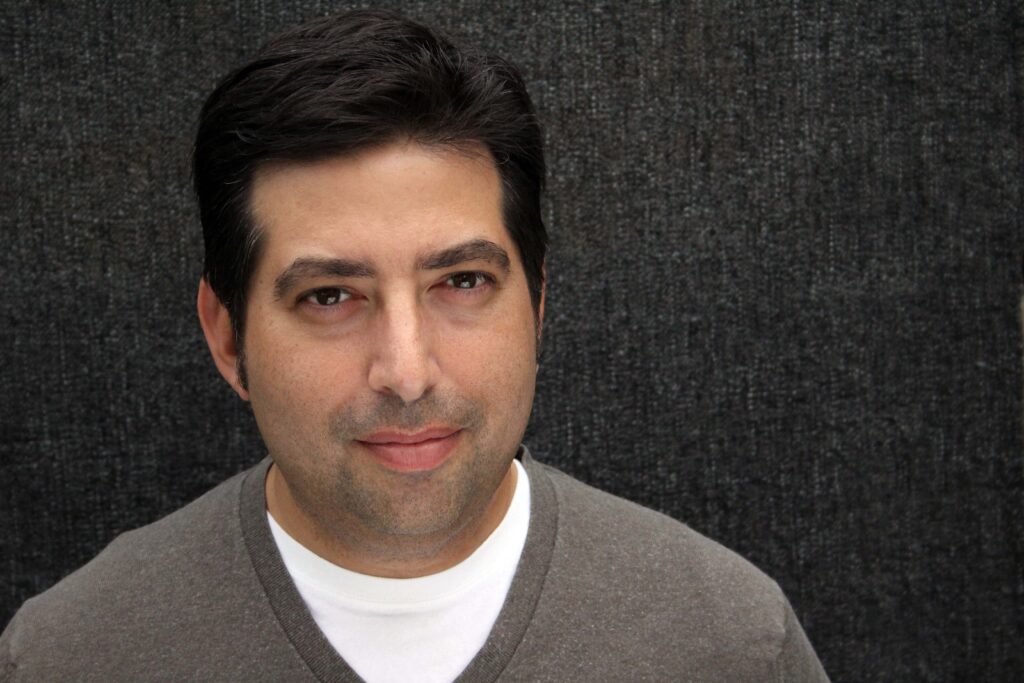
Tod Goldberg’s Mob trilogy concludes with ‘Gangsters Don’t Die’
Crime novels follow Chicago mobster finding new identity as Las Vegas rabbi

The third novel in a Mob trilogy by author Tod Goldberg was released in September, completing the tale of a Chicago hit man on the run after killing three federal agents and a confidential informant.
With the killings behind him, and being hunted, mobster Sal Cupertine leaves Chicago, making his way to Las Vegas and assuming a new identity as Rabbi David Cohen. His wife and son remain back home, not knowing what happened to him or where he is.
The three novels — Gangsterland, Gangster Nation and Gangsters Don’t Die — can be read as standalone thrillers, but when read in order, they guide readers chronologically through a period from the late 1990s into the 2000s, with flashbacks.
Each novel moves through a series of plot twists and, in several cases, deadly encounters. In the first novel, Cupertine states his belief in three things: family, duty and retribution. That theme plays out, sometimes violently, throughout the trilogy.
‘Grist for a crime writer’
Goldberg’s knowledge of the Las Vegas area beyond its casino culture gives his novels an authenticity that challenges stereotypes. Among his 16 published books are 14 works of fiction and two travel guides to Las Vegas.

In the trilogy, the Las Vegas references include names such as Mob defense attorney Oscar Goodman, now a former mayor; local residential areas such as Summerlin; and the state’s largest daily newspaper, the Las Vegas Review-Journal.
Goldberg’s understanding of the territory is evident in concrete details (down to unique plant names) and through his characters’ observations. Many of these observations are humorous, while others are scathing — Las Vegas, to one character, is “a fetid sunburnt bowl of dust in the middle of nothing. Just another Pleasure Island, filled with liars and thieves.”
A native Californian, the 52-year-old Goldberg grew up in Walnut Creek and Palm Springs. Since the 1980s, he has visited Las Vegas often and was a resident from 1998-2000. Currently, he is professor of creative writing and director of the low-residency MFA in Creative Writing & Writing for the Performing Arts program at the University of California, Riverside.
Goldberg’s many trips to Southern Nevada helped spark his creative instincts.
“When you live in the Coachella Valley, skipping across the desert to Las Vegas is an easy jaunt,” he said in an email, “particularly if you go the secret back way, through the nameless desert mining towns where, if you have a good imagination, you start to think about hiding bodies.”
The author’s mother, Jan Curran, was a society columnist for the Desert Sun newspaper in Palm Springs, east of Los Angeles, popular throughout the years among entertainers such as Frank Sinatra and Dean Martin — and with mobsters.
As a newspaper columnist, Curran attended social events in the 1980s and ’90s, putting her in contact with some of the underworld figures in Palm Springs. Goldberg grew up around his mother’s stories and was exposed to even more in Las Vegas, where the Mob was covered extensively in the news media.
“It was all fascinating grist for a crime writer,” said Goldberg, whose brother, Lee Goldberg, also is a best-selling writer, with a new novel, Malibu Burning, now available in bookstores and online.
In Tod Goldberg’s recent trilogy, his knowledge of Chicago adds additional credibility and depth to the novels.
“Chicago is a town I’ve come to love over the last 25 years,” Goldberg said. “I’ve visited many times, and a small press based out of Chicago published two of my early story collections, so I’ve spent a fair amount of time there.”
A recognizable world
With his Mob books, Goldberg said he is attempting to reinvigorate a subject that “waxes and wanes” in public popularity.
“When Gangsterland came out in 2014, I was told beforehand that the Mob novel was dead, that it had been done to death and there was no way to make it more original than The Sopranos managed to do over its incredible run on HBO,” he said.
Goldberg said there was a long period when Mob stories essentially were a rip-off of two classic films, The Godfather, scripted by novelist Mario Puzo and director Francis Ford Coppola, and Goodfellas, which journalist Nicholas Pileggi and director Martin Scorsese co-wrote.
“I absolutely felt pressure writing the first novel in the series,” Goldberg said. “But I decided, ‘Well, I’m going to admit what we all know in the book itself: that Mario Puzo had both created and ruined the modern story of organized crime, that modern gangsters were influenced more by the books and movies than they were about some ancient notion of omertà.’ And once I did that, I think I landed on a recipe for success, which is that you admit the failure of the genre while trying to reinvigorate it.”
For Goldberg, crime stories can go deeper than just action and mystery, though he is highly effective with those components. He said crime fiction “hangs a mirror up to society and forces us to take a hard look.”
“During the pandemic, I found myself settling in for the night by watching some gruesome true crime show, only falling asleep once the killer was behind bars,” he said. “And I realized that I really needed to see chaos reordered in those days when everything felt so unsure. It’s very fulfilling to see justice and the end of chaos, the world reset to some sense of normal. Or at least if not normal, the world is recognizable again.”
In that regard, Goldberg’s books can appeal to readers who prefer literary fiction with complex characters, but also to those who really only want a great story. Goldberg’s list of favorite crime writers shows the influences that shape his work.
“My favorite crime novelists would be Elmore Leonard, who taught me how to create empathy in even the most woebegone characters; Daniel Woodrell, who showed me that to be truly great means to write the novels only you can write; Donald Westlake, who taught me how to end a story; Dennis Lehane, who showed me that emotional and literary complexity has a place in modern crime fiction; and my brother Lee, who paved the road for me,” he said.
He also has learned from authors not thought of as crime writers.
“My favorite novelists in general would include Susan Straight, who taught me that the desert and the Inland Empire can be as vivid as any big city; Richard Ford, whose early stories showed me how to write men with guns who still felt like humans on the inside; Richard Russo, whose novels of small-town conflict remind me, always, that it’s not about the size of the place, it’s about the size of the problem; Margaret Atwood, who has mixed genres for her entire career and done so masterfully; and lastly Robertson Davies, who taught me the nature of fate in fiction.”
Goldberg has other literary influences as well. “About 50,000 others,” he said.
Path toward redemption
The concept of creating mobsters as fully developed characters hits home with other authors. One is Eric Dezenhall, whose novels include The Devil Himself, which explores the U.S. government’s collaboration with mobsters such as Meyer Lansky decades ago in confronting the Nazis.
Dezenhall said the public responds well to an unexpected humanity in these kind of stories, and to “something we never saw coming.”
“I’m thinking about Tony Soprano and the ducks and Donnie Brasco’s Lefty sobbing in the hospital at his son’s drug addiction,” Dezenhall said in an email. “When I wrote The Devil Himself, the angle that interested me was Meyer Lansky’s desire to work with the Navy in the Second World War because he wanted to be an American, to fight Nazis and be a positive part of American history. The thing that got to me most in reviewing Lansky’s private records were the notations he made in books such as ‘remember to look up Thucydides.’”
Mob stories continue to generate interest, Dezenhall said, because they are “a perversion of the superhero fantasy — the idea that there is someone who doesn’t have to play by the rules, do whatever he wants and that everyone fears.”
“At a lizard level, wouldn’t we all like that even though on a moral level we know it’s wrong?” he said. “It’s telling that the angriest anybody got over anything I said about the Mob [in a radio interview] is that Meyer Lansky didn’t have a $300 million fortune, the Mob didn’t compromise J. Edgar Hoover, and Tony Accardo wasn’t more powerful than the president.”
Giving readers fully developed characters, including mobsters like those in Goldberg’s recent trilogy, keeps the story from becoming hackneyed and can uncover truths about human nature.
In Goldberg’s fictional world, a ruthless criminal like hit man-turned-rabbi Sal Cupertine, though deeply flawed and violent, might somehow find himself on a path toward redemption in a religious context.
“Because as much as the books are about an exploration of violence and the culture which abets it, it’s also a journey of the soul, watching how a bad man becomes a better man when he’s exposed to some notion of faith,” Goldberg said.
Larry Henry is a veteran print and broadcast journalist. He served as press secretary for Nevada Governor Bob Miller, and was political editor at the Las Vegas Sun and managing editor at KFSM-TV, the CBS affiliate in Northwest Arkansas. Today, he is a senior reporter for Gambling.com. The Mob in Pop Culture blog appears monthly.
Feedback or questions? Email blog@themobmuseum.org





